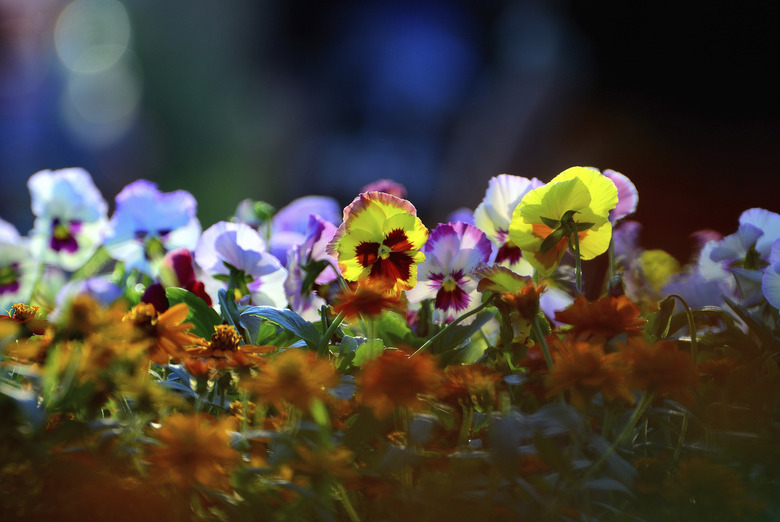How To Get Rid Of Bugs On Pansies
Pansies (Viola x wittrockiana) are rarely bothered by most garden bugs, but aphids and spider mites can do serious damage if they are not kept under control. Pansies are perennials in U.S. Department of Agriculture plant hardiness zones 7 to 10. In colder and hotter climates, however, they are grown as annuals. Aphids and spider mites can become a problem for pansies in any climate. Steps must be taken to get rid of them as soon as they are detected in the garden.
Aphids
Aphids
Aphids are small insects with soft bodies that are tear-drop or pear shaped and 1/16 to 3/8 inch long. They are commonly red, green or tan but can be nearly any color. These bugs pierce the leaves and stems of pansies and suck the plant juices out. As they feed, they secrete a clear sticky liquid called honeydew, which sooty mold, a dark gray or black fungus, grows on and ants eat. Aphids gather on the tops and bottoms of pansy leaves as well as the stems. Check the pansies for aphids once or twice each week at the beginning and end of the growing season which is when aphids flourish. Signs of an infestation are small puckered or curled leaves and reduced blooming with distorted flowers.
High-nitrogen fertilizer encourages aphids. Nitrogen is the first number listed on the fertilizer container. Use slow-release fertilizer with a 5-10-10 ratio. A common application rate is 2 cups per 50 square feet of flower bed. One application in the spring should be sufficient for annuals. Perennial pansies should be given one application in the spring and fall.
Spider Mites
Spider Mites
Spider mites are tiny pests that are barely visible to the naked eye. They pierce the leaves and stems of pansies and suck out the juices. While they are most often found on the undersides of the leaves, they will also feed on the tops. Signs of a spider mite infestation are silvery stippling on the leaves and a fine webbing between them. Eventually, the leaves curl, look bronze and may fall off the plant. Spider mites flourish during the middle and end of summer when conditions are hot and dry. Check pansies once or twice each week during this time for signs of spider mites.
Environmentally Friendly Approach
Environmentally Friendly Approach
The preferred way to get rid of aphids and spider mites is a simple spray of water from the garden hose. This will preserve beneficial insects like ladybugs and praying mantises that eat aphids and beneficial mites that eat plant-feeding spider mites. If they survive, they will be unable to get back on the pansies easily. Adjust the water pressure until it is strong enough to knock the bugs off but not so strong that it damages the pansies. Spray the pansies in the morning so they will be dry by evening to prevent diseases that can occur if the plants stay wet for too long. Direct the spray toward the bottoms and tops of the leaves as well as the stems and flowers. Repeat the spray once or twice each week for aphids or every morning for spider mites until they are gone.
Mild Insecticide
Mild Insecticide
Insecticidal soap kills aphids and spider mites but it should be used only if plain water is unsuccessful. It can be purchased in ready-to-use spray bottles or concentrate form. Mild dish soap can also be used, but do not use highly concentrated or antibacterial dish or dishwasher soap. Mix 5 tablespoons of insecticidal soap concentrate or mild dish soap in 1 gallon of water. Pour the mixture into a spray bottle or hand-pump pressure sprayer and spray the pansies in the morning. Coat the tops and bottoms of the leaves as well as the stems and flowers. Wash it off with clear water from the hose after one to two hours. Insecticidal soap only kills the aphids and spider mites that are coated with it, and it can damage pansies in the hot afternoon sun. Spray the pansies with insecticidal soap every four to seven days until the aphids and spider mites are gone.
Other Pansy Pests
Other Pansy Pests
Slugs and snails come out at night to chew holes in pansy leaves and flowers. They leave a slimy, glistening coating of mucus behind. Use a rake or hands protected by gardening gloves to remove mulch and debris from beneath the pansies where the slugs and snails hide. Lightly moisten the ground with water to encourage them to come out of hiding. Sink shallow tuna or cat food cans into the ground around the pansies until their tops are level with the soil and fill the cans with beer. It attract slugs and snails which fall into the cans and drown. Empty the cans each morning if there are slugs or snails in them, then replace them and refill them with beer.
References
- Floridata: Viola x Wittrockiana
- University of Missouri: Missouri Environment and Garden: Pansy: Always in Bloom Somewhere
- Clemson University Cooperative Extension: Pansy Diseases & Insect Pests
- Missouri Botanical Garden: Aphids – Outdoors
- Clemson Cooperative Extension: Pansies & Johnny-Jump-Ups
- University of Georgia Extension: Care of Ornamental Plants in the Landscape
- Missouri Botanical Garden: Spider Mites — Outdoors
- University of California: UC IPM: Spider Mites
- Colorado State University Extension: Insect Control: Soaps and Detergents
